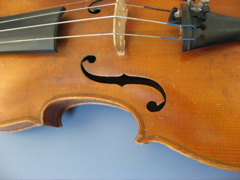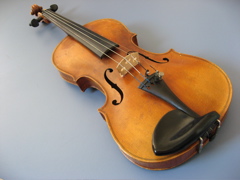Homepage > Documents > String Natural Harmonics Support this website? >>
Higher order natural harmonics and overtones for string with fundamental frequency
String Natural Harmonics - Version 1.0
 This page demonstrates the natural string harmonics. For a given
string fundamental pitch (see the top pull-down menu) six upper partials (fundamental to 5th harmonic overtone) are determined. For playing the finger positions on the string are indicated (nodal points).
[More user guidelines >>]
This page demonstrates the natural string harmonics. For a given
string fundamental pitch (see the top pull-down menu) six upper partials (fundamental to 5th harmonic overtone) are determined. For playing the finger positions on the string are indicated (nodal points).
[More user guidelines >>]
Use this page in landscape mode on mobile devices.
Guidelines for the user
 This JavaScript GUI demonstrates the natural harmonics of a vibrating string. Use this GUI as follows:
This JavaScript GUI demonstrates the natural harmonics of a vibrating string. Use this GUI as follows:
-
Select the String fundamental (i.e., the open string pitch, the first partial) from the pull-down menu with diatonic pitches (c to b) at the top. The sounding pitches of 2nd to 6th upper partial (the harmonic overtone series) are shown in the text boxes on the right.
-
The string vibration patterns, i.e., the sine waveforms corresponding to the upper partials, are shown in the diagrams with the curved blue lines. Carefully pressing the string at the nodes (where the vibration amplitude is zero) will generate the sounding pitch of the upper partials. Therefore, the nodal points (the text boxes in the diagrams) correspond to the finger positions on the string, when playing natural harmonics.
-
The upper partials, i.e., the overtones, may be generated by pressing multiple node points on the string. See e.g., the fourth partial, sounding two octaves above the fundamental. This can be generated by pressing the string at the position corresponding to a perfect fifth above the fundamental (the regular position) or at the node two octaves above the fundamental (less regular, alternative solution).
-
Vertical lines indicate octave positions along the string. The first octave lies at the mid-point of the string, the second octave at 1/4 string length from the bridge, and the third octave (beyond normal playing position) at 1/8 string length from the bridge.
Further reading
- Samuel Adler, The Study of Orchestration, Second Edition. ISBN 0-393-95807-8, W.W. Norton and Company, Inc., New York, 1989, pp. 46-49.
- Alfred Blatter, Instrumentation and Orchestration, Second Edition. ISBN 0-534-25187-0, Schirmer, Thomson Learning, Inc., Belmont, 1997, pp. 33-35.
- Cecil Forsyth, Orchestration. ISBN 0-486-24383-4, Dover Publications, Inc., New York, 1982, pp. 328-331, 389, 423-424, 443-444.
- Kent Kennan, Donald Grantham, The Technique of Orchestration, Fifth Edition. ISBN 0-13-466327-6, Prentice Hall, Upper Saddle River, 1997, pp. 69-71.
- Norman del Mar, Anatomy of the Orchestra. ISBN 0-571-13185-9, Faber & Faber, London, 1983, pp. 112-115.
